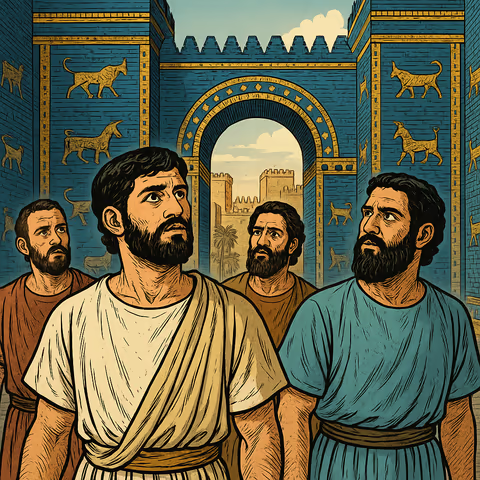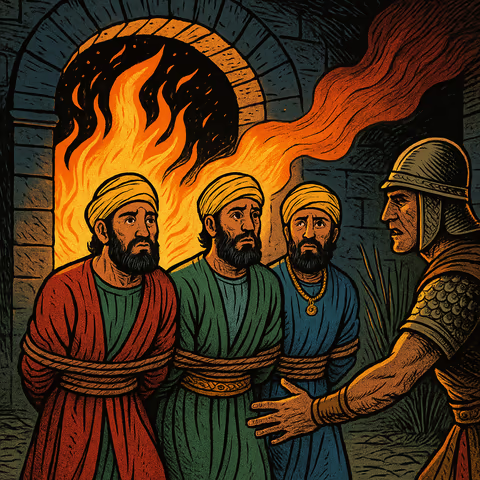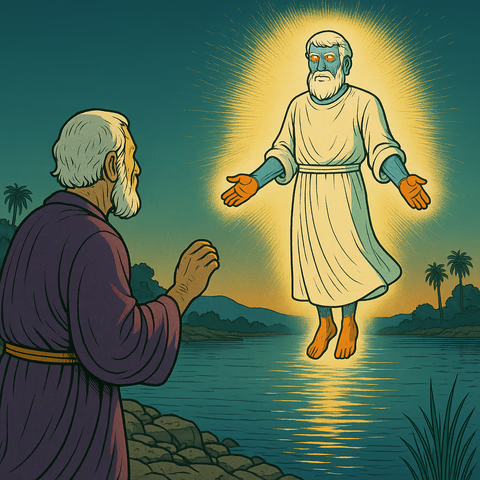
Differences in the Old Greek Version of Daniel (Chapter 9)
The Seventy Weeks Prophecy
This chapter of the ‘Old Greek’ version of Daniel contains 27 verses. Of these, 17 have differences.
The most important differences are in the last verses: 24, 25, 26, and 27. These are extremely different, possibly revealing that the Hebrew text later suffered from a deliberate effort to corrupt it, to make it sound less like the prophecy points to Jesus.
However, even the corrupted Hebrew version can still be seen to point to Jesus, it’s just that certain details don’t make sense and certain numbers don’t add up.
In contrast, the Old Greek version is much more consistent, and it’s the only one that works in the chronology (although some mysteries still remain).
70 years of reproach or desolations?
If you’re a current or former member of Jehovah’s Witnesses, one difference in the Old Greek will be of particular interest to you. Verse 9:2 mentions 70 years of ‘reproach’ – not ‘desolation’ – on ‘the land and JeruSalem.’
This is a critical point which directly contradicts Jehovah’s Witnesses’ Bible chronology and end-times teachings, though it will be of little interest to others. This is partly covered in our article, When Bible Chronology Goes Wrong.
Verse 9:24
Now let’s go through the most important differences, all of which are in the last verses.
The Old Greek version gives GabriEl’s list of what the seventy weeks are for, but it’s a little different from what’s said in the Hebrew version.
The Old Greek text says it is for seven things, but the Hebrew version only mentions six, and states them somewhat differently. Here’s all things compared:
| Old Greek | Hebrew | Comments |
|---|---|---|
| 1. ‘To fulfill sin’ | 1. ‘To finish the transgression’ | No difference. |
| 2. ‘To end injustice/unrighteousness’ | 2. ‘To end sins’ | No difference. |
| 3. ‘To wipe away injustices/unrighteousnesses’ | 3. ‘To atone (or cover) guilt’ | Slight difference; atoning is probably a more familiar term to Hebrew-speakers. |
| 4. ‘To understand the vision’ | (not present in Hebrew) | Either removed from the Hebrew or added to the Greek. |
| 5. ‘To be given righteousness in the age’ | 5. ‘To bring in everlasting righteousness’ | The Greek is personal, the Hebrew is not. |
| 6. ‘To fulfill the visions and prophet’ | 6. ‘To seal up the vision and prophecy’ | Completely the opposite meaning. |
| 7. ‘To make the holy of holies happy’ | 7. ‘To anoint the holy of holies’ | Happy is more general, anointing is more specific. Could be a mistreading of the Hebrew word (we discuss this below). |
Considering how often the number seven is used in the Bible, could it be that the Hebrew version lost point 4? It’s possible, but it’s also possible that the Old Greek version added one for some reason.
But it’s interesting that removing number 4 (‘To understand the vision’) stops the Hebrew version contradicting itself, because number 6 is also different and says the vision will be sealed up (the opposite of being understood!). So it’s like item 4 had to be removed to keep things consistent. But it wouldn’t work the other way… If someone changed item 6, they wouldn’t be forced to add item 4.
The Old Greek version actually fits what happened, because the vision was fulfilled by Jesus and understood by his followers:
- Firstly, they identified him as the Messiah.
- Then, Jesus himself warned the Christians about the ‘abomination of desolation’ appearing in Jerusalem (mentioned in this prophecy in verse 27).
- They knew enough to identify it as the Roman Empire’s attack on Jerusalem.
- Using this information, they understood it and escaped the city.
So the vision wasn’t ‘sealed up.’ It was ‘fulfilled.’ It was ‘understood.’
Lives were saved.
Even before JeruSalem was destroyed, the Christians understood what it meant for sin being finished, as the Apostle Paul explained how Jesus’ death wiped away sin and ended it (Colossians 2:13-14; Romans 6:10-11).
He also explained how Christians were given a rightous standing before God (Romans 5:1; 2 Corinthians 5:21).
Further, he described how the temple was now a spiritual place (‘not made with hands’ Ephesians 2:21-22; compare Hebrews 9:11, 24), not a physical building, and therefore its holy of holies must be where God Himself resides in heaven (Hebrews 9:24).
And it was certainly made ‘happy’ when Jesus presented himself to God as a pleasing sacrifice (Ephesians 5:2).
In the following century we even have letters from the ‘Church Fathers’ explaining the 70 weeks prophecy (Clement of Alexandria, Terutullian, Julius Africanus, Hippolytus of Rome, and Origen), even if their understanding was not perfect (because they were no longer using the Old Greek version).
So was this vision ‘sealed up’ like the Hebrew says?
No.
Just as the Old Greek says, it took 70 weeks to ‘fulfill’ the vision, and they did ‘understand’ it. Then the Christians preached their understanding widely.
The rest of the Hebrew version has further problems. Sure, Jesus did ‘atone’ for our sins, but the ‘holy of holies’ was not ‘anointed’ (or consecrated), because the physical building was destroyed by the Romans, and the spiritual ‘holy of holies’ is in heaven, where God Himself lives, so it has no need to be consecrated… It’s already as holy as it can be! It was only ‘made happy’ as the Old Greek says, when Jesus presented himself to God as a pleasing sacrifice.
Note that it’s possible that the Hebrew word for anoint was misread as the word rejoice (משח versus שמח), but this is the only one that could be explained as a (possible) mistranslation. Therefore, given all the other differences, it’s just as easily another deliberate change.
The question is, which version was deliberately changed, Greek or Hebrew? The Dead Sea Scrolls only have the odd word from this chapter, so that doesn’t help.
But if we had to bet, we’d bet on the Greek version being the original, because it’s what actually happened; it’s clearly fulfilled prophecy. The Hebrew just seems to have been tampered with.
Verse 9:25
This is the famous verse that gives the timing for the appearance of the Messiah.
Now, this verse is very different. In the Old Greek, it’s very short, literally saying:
‘You’ll know and understand, and rejoice, and find commands to respond to, and you will build [the] city [of] JeruSalem for-Lord.’
So we have:
- Unspecified ‘commands’ they’ll respond to,
- They’ll ‘build the city’ of JeruSalem,
- They’ll do it ‘for Lord’,
- There’s no mentioning the temple or the walls or anything like that.
The Hebrew version is much longer, giving a specific starting point and referring to rebuilding the ‘rampart’ (probably meaning the walls):
‘And you know, and consider wisely, from the going forth of the word to restore and to build Jerusalem until Messiah the Leader is seven periods of seven, and sixty-two periods of seven: the broad place has been built again, and the rampart, even in the distress of the times.’ (Literal Standard Version)
As for the 7x7 and 62x7, we’ll consider that in the next verse, because that’s where it appears in the Old Greek version.
So the Hebrew version says there is ‘a specific command’ (not ‘commands’) to rebuild JeruSalem, and it’s specifically mentions the ‘rampart,’ probably referring to the city walls. Every Jew would recognize this as a reference to when NehemiAh famously rebuilt the walls in just fifty-two days (Nehemiah 2:17-18; 6:15).
So what’s the problem?
Well, the Hebrew does not work…
NehemiAh’s rebuilding of the walls was in ~445 BC. Counting forward 490 years (7x70) brings us to the year AD 46, when nothing happened.
However, the Old Greek version does work. It speaks of commands to rebuild the city… not the temple or the walls, but the city. When did that happen?
In 457 BC.
Ezra records how ArtaXerxes gave a command to restore local self-rule in JeruSalem (Ezra 7:12-26). This is a different event from when they rebuilt the temple (that was earlier) and the walls (that was later). Yes, in 457 BC, the command was to build the city by restoring its administration and population (Ezra 7:25).
And what happens when we count forward 70 weeks of years (7x70) from that year?
We end up in the year AD 33… The year of Jesus’ execution. Remember, this prophecy is to ‘fulfill sin’, and Jesus’ death was the ultimate sacrifice for sin.
This also fits perfectly with another verse in this prophecy in the Old Greek. Later, in verse 27, it says that sacrifice and drink offering will cease at the end of the week, presumably meaning the last week (this differs from the Hebrew which says it will stop in the middle of the last week).
The Jewish religious leaders, on the other hand, could not understand this prophecy because they rejected Jesus as the Messiah. But, more than that, they used a completely wrong historical chronology! You see, their historians miscalculated the length of the Persian era… They incorrectly believed the first temple was destroyed in 421 BC — that’s out by over a century and a half!
So there was no way for them to understand this prophecy correctly.
This is all explained in an ancient work called the Seder Olam. It was written around AD 160, and it records the Jewish interpretation of the 70 weeks prophecy. They mistakenly believed that it started with the first temple’s destruction by Babylon and ends with the destruction of the second temple by Rome. Their wrong chronology separated these events by about 490 years, so it kinda ‘worked,’ and that became official Jewish belief (in reality, the gap between these two events was about 656 years).
However, this interpretation came later. We’re looking for possible textual corruptions that came a bit earlier, made to discredit Christians and Jesus… And oh boy, do we find it.
A deliberate corruption?
Let’s explore the possibility that sometime before this (let’s say, around AD 100), someone deliberately corrupted the Hebrew text to establish the starting point as NehemiAh rebuilding the city walls, as that’s how the Hebrew text reads.
Why would someone do that?
Well, in their wildly incorrect chronology, the starting point of NehemiAh rebuilding the city walls would be around the year 331 BC. Counting 490 years forward from that (incorrect) date, brings us to around AD 158.
In other words, if someone did corrupt the text deliberately, they were altering it to make it extremely clear when it started, because that’s exactly how they changed the text… They added the words ‘from the going forth of the word to restore and to build Jerusalem…’. By doing this, they were leaving no doubt that it must apply to the future, to some unknown future Messiah… That there was no way whatsoever it could apply to Jesus… Because AD 158 was still in the future.
Yes, any reader who believed the (incorrect) popular chronology, would read the prophecy in the Hebrew text and discover that it predicts the Messiah’s arrival around 490 years after NehemiAh rebuilt the walls… And everybody knows that would be sometime in the next few decades (how exciting!). Therefore, they would say, ‘It could not have been Jesus. He was just a false prophet who died years ago! The real Messiah is about to show up! He will no doubt free us from the Romans!’
So yes, the Pharisees had both the motive and opportunity to ‘clarify’ the Hebrew text here to remove any doubt that it points to someone in the near future… Not to that dead Jesus fellow.
Now, later on, when a new Messiah failed to arrive, Jewish scholars came up with an entirely different explanation of the 70 weeks prophecy, and this is what’s recorded in the Seder Olam. Their new interpretation completely ignored the starting point of NehemiAh rebuilding the walls (instead interpreting it as the first temple’s destruction), and downplayed any arrival of a Messiah.
What a contrast!
In contrast, the Christians understood the 70 weeks prophecy far better. They:
- Identified Jesus as the Messiah.
- Obeyed his warnings about the ‘abomination of desolation’ happening in Jerusalem.
- Knew Jesus fulfilled the 70 weeks prophecy by fulfilling sin.
And now, today, thanks to modern archaeology, we know that the 70 weeks, or 490 years, ran from 457 BC to AD 33, the year of Jesus’ death and resurrection.
In other words, the Old Greek version fits perfectly!
Verse 9:26
The Old Greek is again very different. It says:
‘And after 7 and 70 and 62, the anointing will be removed and cease to be. Then a kingdom of nations will destroy the city and the holy place, together with the Anointed One. Its end will come with wrath, and until the period of the end, war will be waged against it.’
We should first mention how the Greek grammar of the numbers is very confusing here.
It could just as easily read ‘77 and 62’ or could mean ‘7x70 and 62’. Or perhaps means ‘7x70 and 7x62’. Even though Koine Greek has a specific way to say ‘7x70’, we’re relying on the ancient translator to decide upon its correct meaning and to transmit it to us. Now, he may not have wanted to commit himself to any specific interpretation, so left it as ambiguous (which is actually very wise).
Also, ancient languages just didn’t deal with numbers very well, with them being very easy to muddle in copying.
We’ll come back to these numbers later.
First consider how the ‘anointing will be removed and cease to be.’ Christians would have interpreted this as the Messiah’s death in AD 33, when the temple was no longer anointed (or consecrated). This event was recorded as being when the curtain between the Holy and Most Holy was miraculously torn in two (Mark 15:38).
After this, the reference to a ‘kingdom of nations’ that destroys the city and the holy place sounds like a reference to the Roman Empire destroying Jerusalem and the temple in AD 70. It could not be anything else. (An Empire is a kingdom that contains many different peoples or nations.)
Further, it says it happens ‘with’ the Anointed One. Again, our ancient translator probably didn’t want to commit himself to any specific interpretation, so he left it ambiguous. The grammar could mean that the Anointed One is destroyed along with the city, but it can just as easily mean that the Anointed One also plays a role in that destruction. Early Christians would no doubt have interpreted this as the glorified Jesus executing judgment upon unfaithful JeruSalem who rejected him.
Anyway, what about that 62? That’s not clear…
If it’s 62 weeks of years (7x62 = 434 years), it’s not clear where that period starts or ends. If, alternatively, it just means an additional 62 ‘years,’ it’s not clear what that means either. There is, in fact, a possibility that it does mean 62 actual years, because the next verse (in Greek) calls this period ‘62 years’, not weeks. This is in sharp contrast to the more ambiguous and careful treatment of the other time periods.
One possible explanation is what happens if you go back 490 years and then go back an additional 62 ‘years’ before that, you come to 520 BC, as that’s exactly when Haggai and Zechariah ordered the Jews to resume building the temple (Haggai 1:7-11). But is that really what it means? Who knows. And why would that be important anyway? It’s not clear.
Modern Christians interpret these time periods like this:
- A period of 7 weeks (49 years) for rebuilding the city,
- Followed by 62 weeks (434 years) until Jesus dies,
- Followed by a final 1 week (7 years).
This adds up to a total of 70 weeks (490 years).
Some say the 62 weeks end either when Jesus dies or when he begins his ministry.
The problem with these popular interpretations is that there is no specific event exactly 434 years before Jesus died (or started his ministry). That would be 405 BC (or 402 BC).
So, the exact point of the ‘62’ is unclear.
Others say the first 7 weeks (49 years) is just symbolic (it’s the length of a jubilee), which then leaves the 62 weeks (434 years) after it with no special meaning… But why mix a specific number with a symbolic one?
It remains a mystery. Perhaps people in ancient times knew the answer, but it’s lost to us now.
There was obviously some reason for mentioning the 62 ‘years’ (as it says in the Old Greek version), but it’s not clear what it is.
The Hebrew version states:
‘And after the sixty-two periods of seven [or 62 weeks], Messiah is cut off, but not for Himself, and the people of the leader who is coming destroy the city and the holy place; and its end [is] with a flood, and until the end [is] war, [and] desolations [are] determined.’ (Literal Standard Version)
As you can see, the clear reference in the Old Greek version to the Romans (the ‘kingdom of nations’) is not present. However, the reference to the city being destroyed is still there, just worded differently.
Also, you can see how the 62 years referenced in the next verse of the Old Greek version here appears as 62 weeks in this Hebrew verse, and as we discussed, nobody can really explain what it means, as the theories don’t match specific events.
Verse 9:27
For this final verse, the Old Greek version is also very different, and much longer.
It says:
‘And the sacred agreement will rule many.
And it will again return and be rebuilt,
To its width and length,
Down to the era’s completion.
‘And after 7 and 70 [or 77, or 7x70] time periods and 62 years,
Until the time of the war’s end,
The desolation will be removed,
To strengthen the sacred agreement for many weeks.
‘And at the end of the week,
The sacrifice and drink offering will be taken away,
And the abomination of desolations
Will be upon the temple until its done…
And the desolation will be complete.’
The Hebrew reads:
‘And he made strong the covenant to many one week: and half the week he shall cause the sacrifice and gift to cease, and upon the wing of abominations laying waste, even to the completion, and that determined shall be poured upon the desolation.’
The Old Greek seems to reiterate to DaniEl that JeruSalem will indeed be rebuilt (remember, from his perspective, it’s still in ruins). Then the angelic messenger repeats the time periods, specifying that there is some other period of 62 years (not weeks). This contradicts what the Hebrew version of the previous verse said (that the 62 weeks end with Messiah’s death).
He’s then reminded that the desolation will end, and the ‘sacred agreement’ will be continue. The ‘sacred agreement’, or covenant, reminds us of the agreement God made with Abraham. In other words, the Jewish system would be restored for many weeks of years.
Finally, as it says in the Old Greek version, ‘sacrifice and drink offering’ are taken away at the ‘the end of the week’, which probably means at the end of the ‘last’ week. As we discussed, that may point to Jesus’ death in AD 33.
Finally, we have the reference to the ‘abomination of desolations’ coming upon the temple. This is what Jesus was quoting in Matthew 24:15. And indeed it happened in AD 70 when the Romans came and destroyed the city and temple.
So everything said in the Old Greek version did indeed happen, and in that order.
The Hebrew version of this verse is much shorter and very different. It implies that the ‘sacrifice and gift’ (not drink offering) will cease ‘half-way through the last week.’ That’s a very specific difference, but it’s not clear why the Greek version says the ‘end’ and the Hebrew says ‘half-way through’ that final week.
Further, it’s not obvious why someone would change it (one way or the other)! Nor is there any clear reason how one could be mistaken for the other in translation. A 3.5 year difference doesn’t even point to some event in the Pharisee’s incorrect chronology that they believed at the time. It’s a mystery.
What we can say, however, is that the Old Greek version is the only one that works:
- If we go by the Old Greek, and accept that the 70 weeks of years (490 years) ends when Jesus dies, then 490 years prior is 457 BC, exactly when the decree was given by ArtaXerxes to develop JeruSalem.
- Using the Hebrew text’s counting, if we put Jesus’ death half-way through the last week, we would need to count back 490 years minus 3.5 years (486.5 years). That brings us back to 454 BC, when no specific thing happened. It does not bring us back to the year 445 BC when NehemiAh started rebuilding the city walls, even though that’s exactly what the Hebrew version says you should find.
So:
- The numbers found in the Old Greek fit a specific historical event.
- The numbers found in the Hebrew version don’t fit with events; they’re out by nine years.
Today, some Christian preachers use mental gymnastics and vague statements to make it appear as though the Hebrew version works, but it does not.
Differences
9:1
The Old Greek text calls Darius of Xerxes, but the Hebrew text calls him son of Artaxerxes. This is the second time that we see different names or titles used for the same person. Perhaps there was some confusion over his identity even in ancient times, and not just today.
For more, read our translator note on Darius.
9:2
The Old Greek text says that DaniEl is examining when the 70 years of ‘reproach’ on ‘the land and JeruSalem’ will end.
In contrast, the Hebrew text says that he is examining when the 70 years of the ‘desolations of JeruSalem’ will end.
Here, the Old Greek text is more correct, because the chronology only allows 50 years for JeruSalem to lie destroyed before Zerubbabel leads 50,000 Jews back to the city. See our timeline for more.
9:3
The Greek grammar suggests a possible circumlocution of God’s Name, but the Hebrew version of this verse doesn’t have YHWH here.
So either this reveals where God’s Name used to be in the Hebrew, or it’s just a grammar choice of the Greek translator.
9:4-7
No important differences.
9:8
Where the Old Greek text refers to God as ‘Master’ (despota), the Hebrew text uses ‘Yahweh’ (יְהוָֽה). This suggests that the Greek translators also circumlocuted Yahweh with Master in places, not just with Lord.
9:9
The Old Greek text comments that ‘righteousness and mercy’ belong to the Lord, but the Hebrew text says it’s ‘mercy and forgiveness’.
9:10
The Old Greek text mentions that God’s laws came through ‘Moses’ and through ‘the prophets,’ but the Hebrew text doesn’t mention Moses.
9:11-12
No important differences.
9:13
The Old Greek text has an extra possible circumlocution for God’s Name right at the end, but the Hebrew text doesn’t.
9:14
No important differences.
9:15 (i)
We now find an additional possible circumlocution for God’s Name in the Old Greek text, but the Hebrew text does not use YHWH here.
9:15 (ii)
The Old Greek text has DaniEl saying that they were ‘ignorant,’ but the Hebrew text says they acted ‘wickedly.’
9:16
No important differences.
9:17
The Old Greek text has DaniEl pleading with God to turn his face to ‘your desolate holy mountain,’ but the Hebrew text asks for God to turn to his ‘desolate sanctuary’ (meaning the Temple). This is obviously referring to the same place, so the difference is probably cosmetic, perhaps ‘holy mountain’ sounds more poetic.
9:18
The Old Greek text has DaniEl add an extra clause at the end (‘Lord, be merciful!’), but the Hebrew text doesn’t include it. Perhaps it was lost in copying, or maybe the Greek translator added it to be more poetic.
9:19-20
No important differences.
9:21
The Old Greek text merely states that GabriEl was ‘brought’ to DaniEl ‘at great speed,’ but the Hebrew text uses an odd phrase that’s hard to translate, saying that he (literally) was ‘being wearied with weariness.’ Some suggest this means he flew to him quickly, but it’s not clear.
9:22
No important differences.
9:23 (i)
In the Old Greek text explicitly says that the command to explain things came from ‘Lord,’ which is another possible circumlocution for God’s Name, but neither ‘Lord’ nor ‘YHWH’ is found in the Hebrew version here.
This suggests that God’s Name may have originally been here in the Hebrew text, but was later removed, or it could just be a grammar choice of the Greek translator.
9:23 (ii)
The Old Greek text literally says that DaniEl is ‘pitiful,’ meaning something like ‘worthy of compassion’ (at least, that’s how we translate it). The Hebrew text instead says he is ‘greatly beloved.’
The difference is probably just a matter of style.
9:24
The Old Greek version lists seven things that the vision will bring in, but the Hebrew lists six, and they’re slightly different.
We discussed this in great detail in our introduction to this chapter.
9:25
The Old Greek version is more vauge about the starting point of the 70 weeks, but the Hebrew version is more specific.
We discussed this in our introduction to this chapter.
9:26
Here the grammar of the Old Greek is very confusing, with the numbers being very unclear. But it’s also more specific, with a possible reference to the Roman Empire. The Hebrew sounds similar, but is more vague.
We discussed this in our introduction to this chapter.
9:27
The Old Greek version is much longer than the Hebrew version, and it also has different details about the time periods.
We discussed this in our introduction to this chapter.
Contents
 Introduction to
Introduction to
Differences in Daniel Differences
Differences
in Chapter One Differences
Differences
in Chapter Two Differences in
Differences in
Chapter Three Differences
Differences
in Chapter Four Differences
Differences
in Chapter Five Differences
Differences
in Chapter Six Differences in
Differences in
Chapter Seven Differences in
Differences in
Chapter Eight Differences in Chapter Nine
Differences in Chapter Nine Differences
Differences
in Chapter Ten Differences in
Differences in
Chapter Eleven Differences in
Differences in
Chapter Twelve